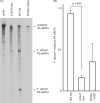Influenza C virus NS1 protein upregulates the splicing of viral mRNAs
- PMID: 20007279
- PMCID: PMC2812400
- DOI: 10.1128/JVI.01627-09
Influenza C virus NS1 protein upregulates the splicing of viral mRNAs
Abstract
Pre-mRNAs of the influenza A virus M and NS genes are poorly spliced in virus-infected cells. By contrast, in influenza C virus-infected cells, the predominant transcript from the M gene is spliced mRNA. The present study was performed to investigate the mechanism by which influenza C virus M gene-specific mRNA (M mRNA) is readily spliced. The ratio of M1 encoded by a spliced M mRNA to CM2 encoded by an unspliced M mRNA in influenza C virus-infected cells was about 10 times larger than that in M gene-transfected cells, suggesting that a viral protein(s) other than M gene translational products facilitates viral mRNA splicing. RNase protection assays showed that the splicing of M mRNA in infected cells was much higher than that in M gene-transfected cells. The unspliced and spliced mRNAs of the influenza C virus NS gene encode two nonstructural (NS) proteins, NS1(C/NS1) and NS2(C/NS2), respectively. The introduction of premature translational termination into the NS gene, which blocked the synthesis of the C/NS1 and C/NS2 proteins, drastically reduced the splicing of NS mRNA, raising the possibility that C/NS1 or C/NS2 enhances viral mRNA splicing. The splicing of influenza C virus M mRNA was increased by coexpression of C/NS1, whereas it was reduced by coexpression of the influenza A virus NS1 protein (A/NS1). The splicing of influenza A virus M mRNA was also increased by coexpression of C/NS1, though it was inhibited by that of A/NS1. These results suggest that influenza C virus NS1, but not A/NS1, can upregulate viral mRNA splicing.
Figures










Similar articles
-
Splicing of influenza A virus NS1 mRNA is independent of the viral NS1 protein.J Gen Virol. 2010 Sep;91(Pt 9):2331-40. doi: 10.1099/vir.0.022004-0. Epub 2010 Jun 2. J Gen Virol. 2010. PMID: 20519456
-
The accumulation of influenza A virus segment 7 spliced mRNAs is regulated by the NS1 protein.J Gen Virol. 2012 Jan;93(Pt 1):113-118. doi: 10.1099/vir.0.035485-0. Epub 2011 Sep 14. J Gen Virol. 2012. PMID: 21918006
-
Nucleocytoplasmic transport: the influenza virus NS1 protein regulates the transport of spliced NS2 mRNA and its precursor NS1 mRNA.Genes Dev. 1992 Feb;6(2):255-67. doi: 10.1101/gad.6.2.255. Genes Dev. 1992. PMID: 1531330
-
Nuclear functions of the influenza A and B viruses NS1 proteins: do they play a role in viral mRNA export?Vaccine. 2009 Oct 23;27(45):6312-6. doi: 10.1016/j.vaccine.2009.01.015. Vaccine. 2009. PMID: 19840666 Review.
-
[Influenza virus genome structure and encoded proteins].Nihon Rinsho. 1997 Oct;55(10):2542-6. Nihon Rinsho. 1997. PMID: 9360369 Review. Japanese.
Cited by
-
Role of the CM2 protein in the influenza C virus replication cycle.J Virol. 2011 Feb;85(3):1322-9. doi: 10.1128/JVI.01367-10. Epub 2010 Nov 24. J Virol. 2011. PMID: 21106743 Free PMC article.
-
Functional Characterization and Direct Comparison of Influenza A, B, C, and D NS1 Proteins in vitro and in vivo.Front Microbiol. 2019 Dec 17;10:2862. doi: 10.3389/fmicb.2019.02862. eCollection 2019. Front Microbiol. 2019. PMID: 31921042 Free PMC article.
-
Epidemiology and Clinical Characteristics of Influenza C Virus.Viruses. 2020 Jan 13;12(1):89. doi: 10.3390/v12010089. Viruses. 2020. PMID: 31941041 Free PMC article. Review.
-
Influenza viruses and mRNA splicing: doing more with less.mBio. 2014 May 13;5(3):e00070-14. doi: 10.1128/mBio.00070-14. mBio. 2014. PMID: 24825008 Free PMC article. Review.
-
T Cell Responses to Influenza Infections in Cattle.Viruses. 2025 Aug 14;17(8):1116. doi: 10.3390/v17081116. Viruses. 2025. PMID: 40872830 Free PMC article. Review.
References
-
- Alamgir, A. S. M., Y. Matsuzaki, S. Hongo, E. Tsuchiya, K. Sugawara, Y. Muraki, and K. Nakamura. 2000. Phylogenetic analysis of influenza C virus nonstructural (NS) protein genes and identification of the NS2 protein. J. Gen. Virol. 81:1933-1940. - PubMed
-
- Betakova, T., and A. J. Hay. 2007. Evidence that the CM2 protein of influenza C virus can modify the pH of the exocytic pathway of transfected cells. J. Gen. Virol. 88:2291-2296. - PubMed
-
- Bukrinskaya, A. G., N. K. Vorunova, G. V. Kornilayeva, R. A. Narmanbetova, and A. J. Hay. 1982. Influenza virus uncoating in infected cells and effect of rimantadine. J. Gen. Virol. 60:49-59. - PubMed
-
- Ciampor, F., C. A. Thompson, S. Grambas, and A. J. Hay. 1992. Regulation of pH by the M2 protein of influenza A viruses. Virus Res. 22:247-258. - PubMed
-
- Enami, M., G. Sharma, C. Benham, and P. Palese. 1991. An influenza virus containing nine different RNA segments. Virology 185:291-298. - PubMed
Publication types
MeSH terms
Substances
LinkOut - more resources
Full Text Sources
Miscellaneous

